☰ Nav Menu
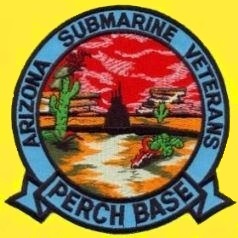
Perch Base
Henry Strickland
(Pappy) Yates, MMC(SS)
Henry (Pappy) Strickland Yates
Henry (Pappy) Strickland Yates, MMC(SS) was a Chief Machinist Mate (SS) on board the USS Perch when it was
scuttled on March 3, 1942. The U.S. Navy had no knowledge of the loss and reported the USS Perch as "missing" in April 1942.
About a year later, a Japanese radio broadcast (Tokyo Rose?) reported that Pappy was alive, but reported that he was in a prison camp
on Shikolu Island, one of the Japanese mainland islands. One might guess that the the erroneous (or misleading) location might have been
intentional to try to keep the Allies from bombing the Japanese mainland. It wasn't until after the Japanese surrender on August 14, 1945,
that the Allied forces learned that he and the surviving crew were in the Makassar POW camp in Indonesia all along.
We did not know much about Chief Yates until Dan Marks, the Perch Base Webmaster, was contacted by Rich Curtis who found a
box in an antique shop in Alabama that included writings by Pappy while he was a POW, describing how terribly they were
treated.
Many USSVI bases are named after boats on Eternal Patrol. The USS Perch (SS-176) is our Base namesake. When Rich Curtis was trying
to find out what to do with the box, he searched the internet and made contact with me, Dan Marks, as Webmaster of Perch Base.
Rich Curtis asked me what he should do with the contents of the box and I suggested that he donate them to the St. Marys Submarine
Museum in St. Marys, Georgia. I presume he did, but he also sent me pictures of the contents. I have catalogued and
presented the results on this website. Although I am not a "historian," I've done my best to preserve this bit of history!
Much of the collection is difficult to read and many of my comments are speculation, but they might be also useful to someone else when
combined with other materials.
Henry (Pappy) Strickland Yates was born January 22, 1909 and enlisted in the Navy on
August 3, 1935. He was assigned to the USS Stingray (SS-186) on March 15, 1938 as a Machinist Mate 1st Class.
Pappy was later transferred to the USS Perch (SS-176) on Oct 13, 1939. He was promoted to Chief, MMC(AA) (acting assignment)
shortly thereafter on November 16, 1939, and MMC(PA) (permanent assignment) on November 14, 1940.
The USS Perch was scuttled on March 3, 1942, and he began his next 3 and 1/2 years as a POW, arriving at the Makassar POW
camp on March 10, 1942. His liberation from the Makassar POW camp is officially recorded as September 17, 1945, which is the
date he was airlifted out to Borneo.
He was recorded and listed as commissioned to Lieutenant, effective January 1, 1945. He was promoted to Lt. Commander August 1, 1951,
retiring from the Navy in December 1954.
Henry (Pappy) Strickland Yates passed on to Eternal Patrol on July 22, 1989.
The following set of Henry (Pappy) Yates' journal entries were recorded while he was still a prisoner in the Makassar POW camp.
The left column is a scanned photo of the actual journal entry. They are generally presented in date order, although many pages did not include
dates and are simply filed after the pages that had dates. The earliest date was June 29, 1945. The last date was September 11, 1945. The Japanese
surrender was on August 15, 1945, although the Makassar POW camp was not liberated until September 18, 1945, because the allied forces
did not even know the camp existed.
The middle column is my best effort to document the text of the entry, which was often difficult to read due to fading, handwriting, unknown
context and unknown names of others in the camp.
Finally, the right column is solely my attempt to add understanding. Some of this right column content is purely speculative on my part.
The file (and journal) is 39 pages long (9 mB.) Some of the highlights include:
1) The notes are written on Japanese Cherry Blossom brand cigarette wrapper. It is understood that POWs were not allowed to have
paper from discussion by other POWs interviewed. It is presumed that the Japanese guards would throw away empty cigarette packs
and Pappy would scavenge the discarded paper.
2) Pappy was burying records. As the war approached the Japanese mainland, I wonder if the Japanese were on a "search &
destroy" mission to keep the POWs from being able to produce records of the Japanese atrocities in the camp in the event
of a military tribunal.
3) Even as the POWs were suffering their worst starvation and disease toward liberation, Pappy showed hope, in that he still
documented possible inventions, future job opportunities and motivational statements.
4) Most of the camp residents were enlisted men because the Japanese usually took away the surviving officers (and radiomen) to
Japan for interrogation. As a Chief Machinist Mate, Pappy was probably one of the highest ranking men in the American
barracks and his journal notes reflect that he took charge.
Click on the thumbnail to open Pappy's POW Journal.
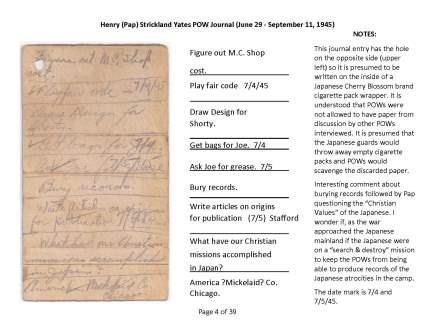
Pappy's journal kept while interred in the Makassar POW camp. (39 pages)
The following set of Henry (Pappy) Yates' journal entries were recorded after the Makassar POW camp was liberated.
The top of each page is my best effort to document the text of the entry, which was often difficult to read due to fading, handwriting, unknown
context and unknown names of others in the camp.
The bottom half of the page is a scanned photo of the actual journal entry. The Post Liberation Journal is presented in date order.
The earliest date was September 5, 1945. The last date was September 18, 1945, after he had been airlifted out of Makassar, taken to Borneo,
and later to Palawan.
The Post Liberation file (and journal) is 30 pages long (4 mB.) Some of the highlights include:
1) Frustration with both the Dutch and English response to the liberation. Pappy discussed the slow response and the lack of
care for the other residents who suffered under the Japanese occupation of the Indonesian island. It seemed to Pappy that
all the other nationalities had the habit of "letting the Yanks do it."
2) Pappy was concerned for the 1,600 women & children of Kampili, in bad need of relief.
3) Pappy pines to return to his wife, Rose Yates, his "Red Rose."
Click on the thumbnail to open Pappy's Post Liberation Journal.
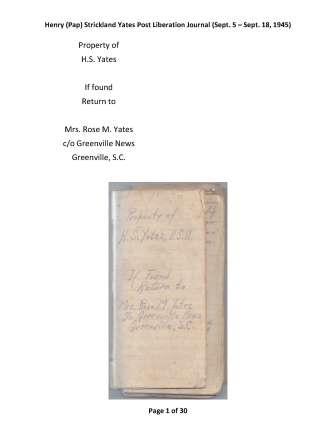
Pappy's journal kept after the Makassar POW camp had been liberated. (30 pages)
Some additional documents found in the box by Rich at the antique store:
Click on the thumbnails to open these other documents.

Pappy recorded some key dates while he was a POW. (2 pages.)

Documenting treatment of POWs. Appears to have been written after the Japanese surrender. (2 pages.)
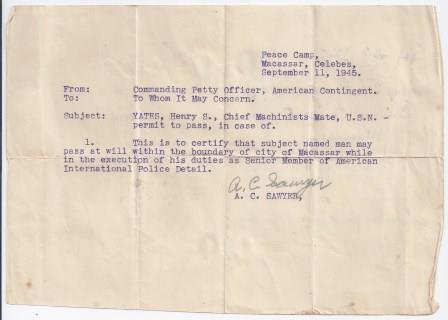
Pappy was the Senior Member of American International Police Detail. In that capacity, he saw that the atrocities of
the Japanese occupation of the Celebes Island extended beyond just the Americans. The autograph of Wang Teh Fung, the
Chinese Consulate of Makassar is included. (2 pages.)
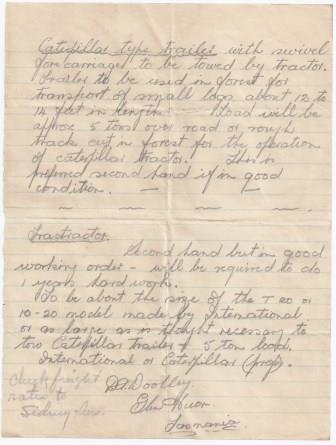
A note, likely written immediately after the POW camp control was taken over from the Japanese to the Allied forces, requesting
equipment to improve living conditions on the island. (1 page.)
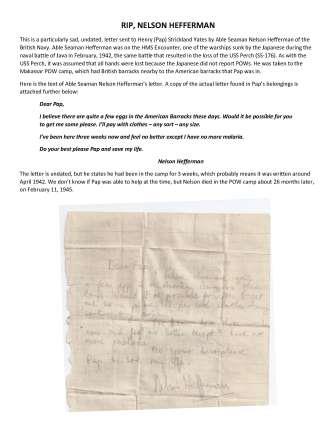
A sad story:
RIP Nelson Hefferman.
(1 page)
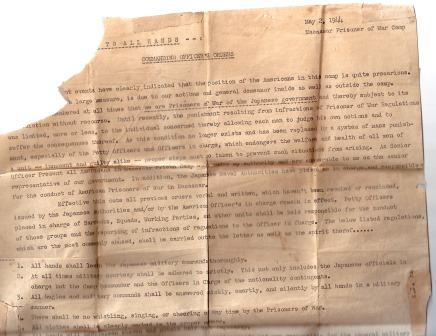
POW Camp Orders issued by the American Officer in Charge on 5/2/1944 (2 pages)
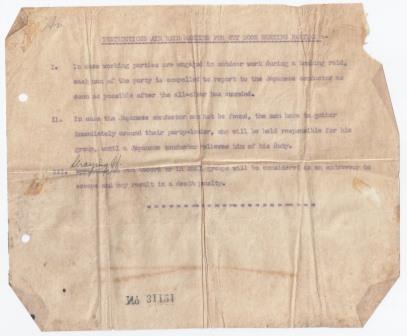
Another set of POW Camp Orders (undated) telling POWs how to respong during bombing raids to avoid being
accused of trying to escape. Because the Allied forces did not know that the Japanese occupation of Makassar included a
POW camp, they conducted many bombing raids. (1 page)
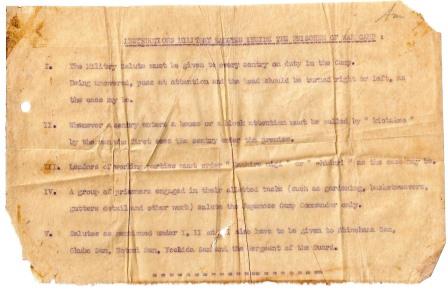
Another set of POW Camp Orders (undated) instructing POWs how and when to salute their Japanese captors. (1 page)
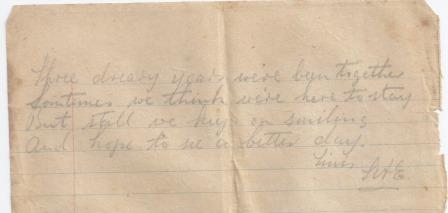
A song written about 3 years into the incarceration as a POW. (1 page)
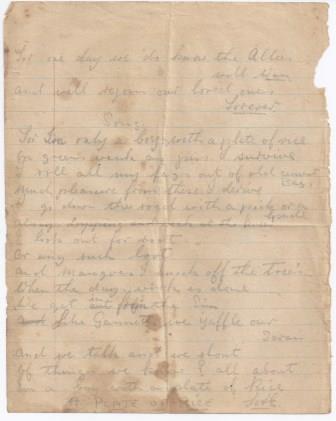
A poem of hope and another song titled "A Plate of Rice" while waiting for the Allied Forces to come. (1 page)















